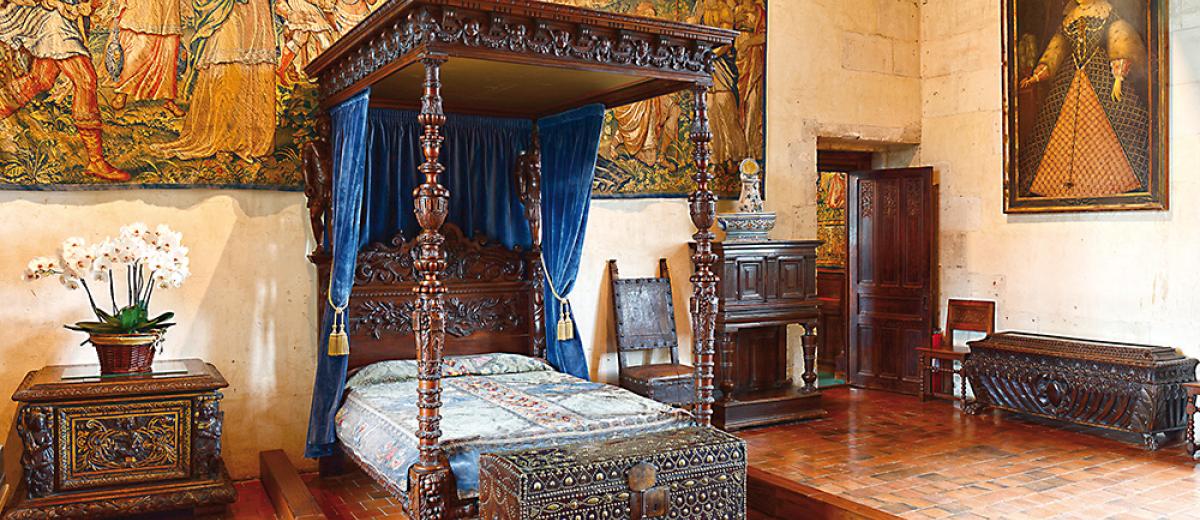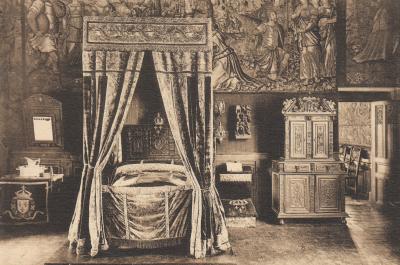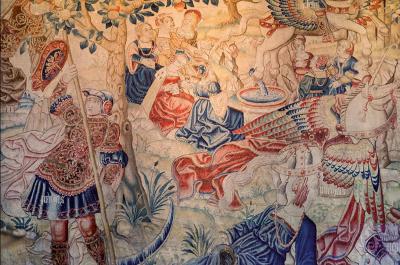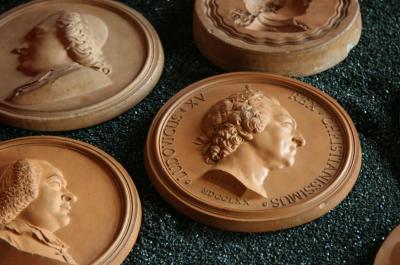The so-called Catherine de Medici room

This room is named as such by the de Broglie family to commemorate the acquisition of the Château by the queen in 1550. In the 16th century, it could serve as a state room, a dining room, a bathroom or a reception room.
The room boasts the oldest tapestry in the Château’s collections, woven in Tournai in the late 15th century (The Story of Perseus and Pegasus). We can also admire the full-length portrait of Catherine de Medici (copy created in the 19th century), a late 16th century tapestry from the Flanders factory (The Story of David and Abigail) and a remarkable 19th century Henri II style bed elaborately carved. This room is also furnished with a 16th century throne, as well as a wardrobe close to the bed whose façade, which dates back to the 15th century, evokes iconography typical of this period; on the upper part, the three theological virtues (faith, hope and charity) and the four seasons, and on the lower part, the five senses.
Also on display in this room are seventy medallions and eight moulds made in the 18th century by the Italian artist Jean-Baptiste Nini. He painted the portrait of a great many famous figures of his time (Louis XV, Louis XVI, Marie-Antoinette, Benjamin Franklin and all the members of the Leray family) as well as more modest townsfolk (doctor, solicitor, registrar). Today, this collection is recognised to be the world’s largest and most prestigious.
Tapestry depicting The Story of Perseus and Pegasus
This tapestry of Perseus and Pegasus, the oldest in the Château, was owned by the Prince and Princess de Broglie, as were the two others hanging in this room. They put together a sumptuous collection of tapestries, dating from the 15th to the 18th century, as part of their idea of reconstructing the original decoration in this part of the Château. This collection is now considered to be one of the most important in the Loire Valley. Woven in the late 15th century in Tournai, the tapestry depicts The Story of Perseus and Pegasus.
Perseus is armed with a scythe and a shield, which the goddess Athena is handing him in the top-left corner. In order to avoid the Gorgon Medusa's gaze, which would turn him to stone, Perseus has cut off her head. Blood spurts from her neck and gives birth to Pegasus, the winged horse of the gods in Greek mythology. Then, in the centre, is a singing contest between the daughters of Pierus and the nine muses of Apollo. Mount Helicon, overjoyed by the sweet music, swells and threatens to reach the sky. Pegasus, on the orders of Zeus, the king of the gods, strikes Helicon with its hoof to restrain the mountain and force it to return to its original size. The mountain obeys and spouts a new spring which encourages poetic inspiration. The spring gives birth to the poet Orpheus, who's visible in the bottom-right-hand corner of the tapestry.


